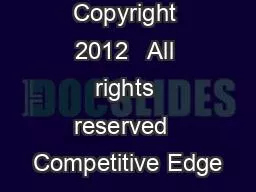

This article and the information contained herein are the intellectual property of Competitive Edge5Assign a lead captain Someone should be assigned the responsibility of monitoring lead count and qua ID: 897209
Download Pdf The PPT/PDF document "Copyright 2012 All rights reserved Co..." is the property of its rightful owner. Permission is granted to download and print the materials on this web site for personal, non-commercial use only, and to display it on your personal computer provided you do not modify the materials and that you retain all copyright notices contained in the materials. By downloading content from our website, you accept the terms of this agreement.
1 Copyright 2012 . All rights reserved.
Copyright 2012 . All rights reserved. Competitive Edge. This article and the information contained herein are the intellectual property of Competitive Edge. 5. Assign a lead captain : Someone should be assigned the responsibility of monitoring lead count and quality at the end of a shift and/or end of the day. 6. Quickly route leads: You need to get the leads to the people who will follow - up on them quickly. Time is of the essence. The value of a lead diminishes by 15% per week. Use your CRM system, phone calls, email and/or fax to get leads to the right people fast. 7. Create a lead reporting process : The most critical element in a closed loop lead management process is a lead reporting system that your reps and/or distributors can use to inform you of what becomes of the leads they receive. If your company uses a CRM system you can probably enter leads and monitor progress through y our system. If not, you need to create another method. Entering leads into an Excel spreadsheet and e - mailing it to your reps can be very effective. Just make sure you ask for lead progress and sales conversion at specific timeframes like 60, 90 and 180 da ys after the show. The most important thing to remember is that your exhibiting ROI is usually hidden in your leads. By setting specific lead goals, taking better quality leads, quickly routing leads to the right people, and providing them with a simple and easy to use reporting process , you will see a lot more of your show leads convert to sales. And that is the bottom line. - Jefferson Davis , p resident of Competitive Edge is known as the “ Tradeshow Turnaround Artist ". Since 1991, his consulting and training services have helped clients improve their tradeshow performance and results to the tune of over $ 50 0M. Mr. Davis can be reached at 704 - 814 - 7355 or Jefferson@tradeshowturnaround.com Copyright 2012 . All rights reserved. Competitive Edge. This article and the information contained herein are the intellectual property of Competitive Edge. From Leads to Sales: How to Develop a “Closed Loop” Lead Management System By Jefferson Davis, Competitive Edge For most exhibitors, the real product of a tradeshow is leads and most companies exhibiting return on investment is tied up in their leads. Knowing this you would think all exhibitors follow - up on their leads. Not so. Ex
2 hibition industry research finds tha t 8
hibition industry research finds tha t 87% of leads captured at a tradeshow are never effectively followed - up. This is a huge problem costing exhibitors hundreds of millions of dollars in unrealized business opportunities. It also presents a great opportunity for exhibitors who do follow - up. Here are 7 steps that can help you create a “closed loop” lead management system so your company can follow - up and convert more leads to sales. 1. Define what is and isn’t a lead: A few words scribbled on a business card or just swiping an attendee’s badge is not a qualified lead. There are four criteria to a qualified lead: 1. personal interaction, 2. key questions asked, 3. answers documented, 4. a next step has been identified and agreed upon by the visitor. 2. Set specific lead goals : To set a lead goal, multiply the number of show hours by the number of staff working your booth. (20 hours x 4 staff = 80 staff hours) Next, multiply staff hours by a conservative number of target interactions per staffer/per hour and person. (80 x staff hours x 4 interacti ons per hour = 320 total interactions) Finally, multiply total interactions by .25 to determine your lead goal. (320 x .25 = 80 qualified leads) Once you’ve established your lead goal be sure to communicate it to your staff and make them accountable for a chieving the goal. You might even consider creating daily contests to increase staff focus even more. 3. Identify the best information you could capture : Besides general contact information like name, company, address, phone, fax and email, “What information , if captured, would help you better understand and qualify the opportunity?” Your answers might include familiarity with your company, product or service, problems they are having, current supplier or method of dealing with the problem, decision team mem bers, decision process, budget, time frame, next action step and so on. Ask your sales and marketing staff for input to identify the most relevant information. 4. Design a custom lead capture device : Most shows offer an electronic lead capture device. Be sure to use it – even if it costs a little extra. As an adjunct to the capture device, consider creating your own custom hand held lead form. It can act as a prompt for your staff on what questions to ask and serve as a quick and easy place to capture imp ortant visitor information.